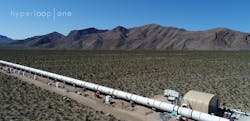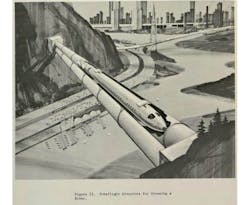Advanced by Elon Musk, the Hyperloop transportation concept would propel passengers and cargo in pods down evacuated tube guideways between cities at near “supersonic” speeds. Last week, one of the operations trying to develop the technology, Hyperloop One, revealed a successful test along a portion of its track near Las Vegas back in May. The facility is a tube about 1,600 ft. (500 m) long, 10.8 ft. (3.3 m) in diameter and capable of being evacuated.
The trial accelerated a magnetically levitated test sled at 2g to 70 mph (112 kph) and lasted 5.3 sec., traveling roughly a third of the track. Tested was the combined operation of the linear induction motor, carriage suspension, levitation system, and vacuum pumping equipment. The latter reduced pressure to 5 pascals (7.25 × 10−4 psi), about that at 240,000 ft. altitude. The next objective is 250 mph (400 kph) using the full track length.
The video Hyperloop released showed the test and subsequent popping of champagne. While this was a milestone for its effort, stepping back one can say that such technologies, with perhaps the exception of integrated operation in a vacuum, have been demonstrated before.
Once operation along the full track length is shown, the next advancement might be establishing continuous travel in a true loop, a track that completes a full circuit. That, however, may show the rub in the Hyperloop concept—namely, g forces that are uncomfortable for the passengers.
The 2g acceleration in the test, while not at roller-coaster level, may prove uncomfortable for many. At the high speeds envisioned for intercity transit, turns need to be very gradual to moderate centripetal acceleration to a comfortable point. Elevation differences are less of a concern, with possible grade changes comparable to gradual grades experienced in rail travel.
Gentle curves will be easiest to achieve in wide open areas, as in the American West. But more congested regions, around cities the service is targeted at, could prove problematic. Recently Amtrak withdrew proposals to straighten out a segment of its Northeast Corridor route to allow higher-speed service through eastern Connecticut and Rhode Island after protests from citizens, businesses, and local governments. If wide curves cannot be made, reducing the speed of the Hyperloop passenger pods would keep centrifugal forces in check. But if speed reductions result in trip times not significantly faster than high-speed rail for the extra cost of the new technology, its justification will be reduced.
One aspect of Hyperloop technology needing resolution before any passengers can travel is safety of those riding within vehicles operating in a literal vacuum. An aircraft gets its air from pressurizing the atmosphere it flies through. Hyperloop pod air would be self-contained. Handling a vehicle structural breach requires redundant systems. Dealing with a pod that “breaks down” en route necessitates safety systems and protocols to protect both passengers and first responders coming to their aid.
Progress in developing Hyperloop technology offers another prospect of high-speed, city-center-to-city-center travel. Adroit engineering to meet its challenges, at a reasonable cost, could provide more options for convenience and time savings.
Forgotten Legacy?
The prospect of Hyperloop transportation has received much attention, and justifiably so. Interestingly, previous tube transport technology development has not gotten acknowledgement from those involved in current projects.
Specifically, Project Tubeflight was underway back in the 1960s at Rensselaer Polytechnic Institute (where this writer was a student at the time). The idea was postulated by Joseph Foa, head of the aero engineering department. Vehicles would be supported by air pads away from the walls of the tubes they “flew” through. A propeller at the rear furnished propulsion by transferring air from the front to the rear. Speeds were expected in the 300 mph range. There was even a version that used another Foa invention—a “bladeless” propeller at the rear that spun sheets of air out of a rotating hub, filling the tube diameter and pushing back the air in the tube.



